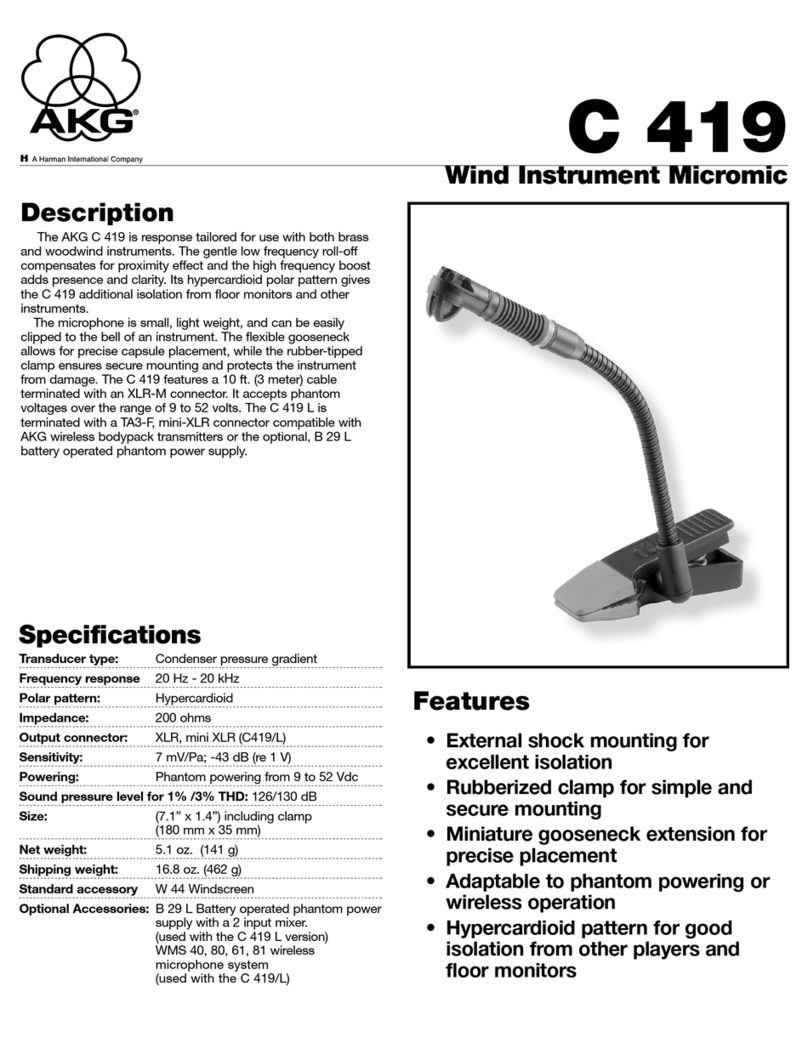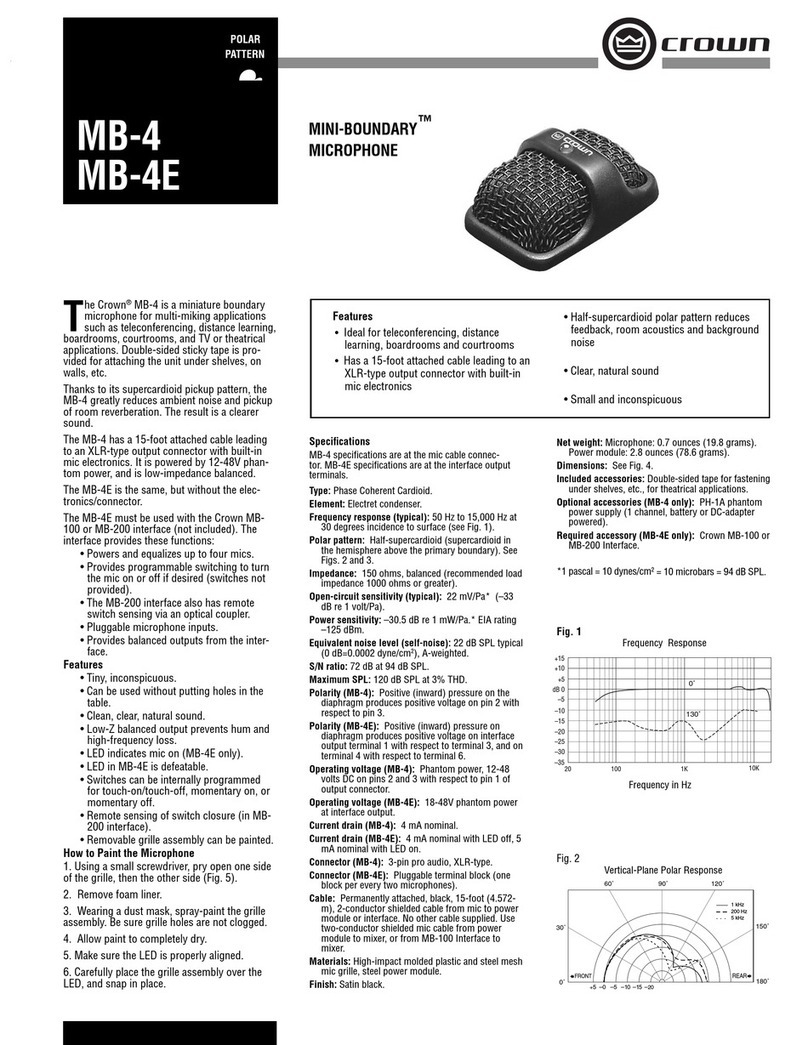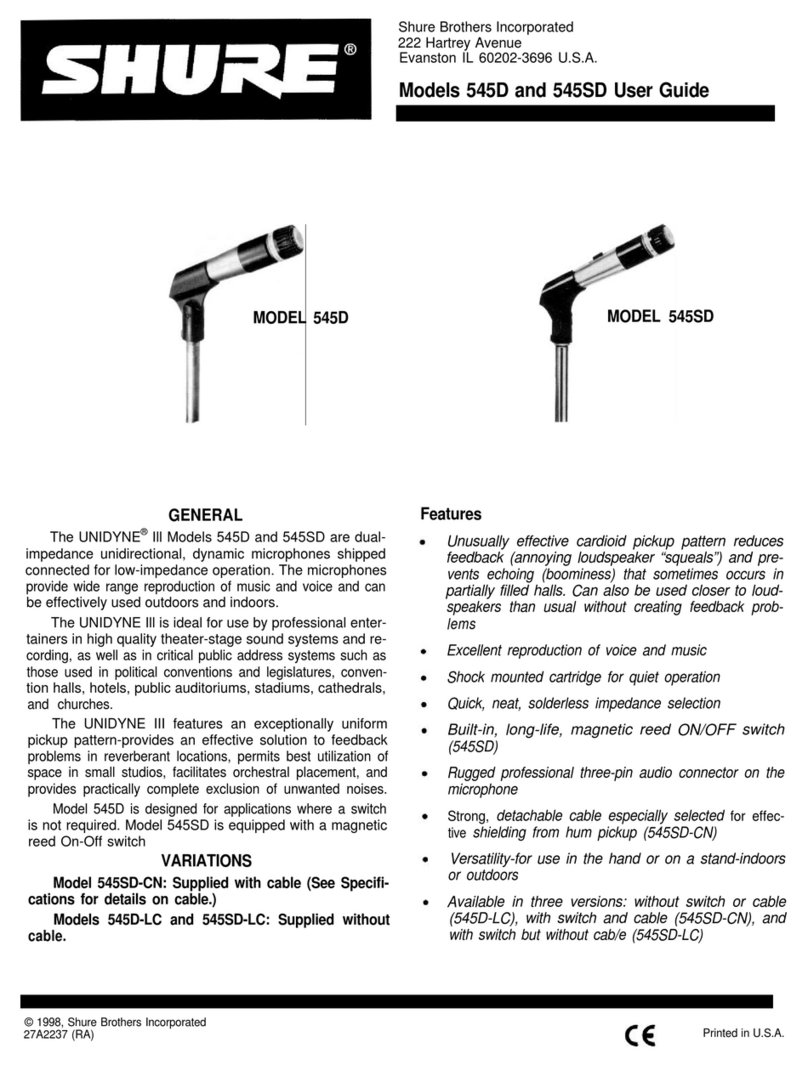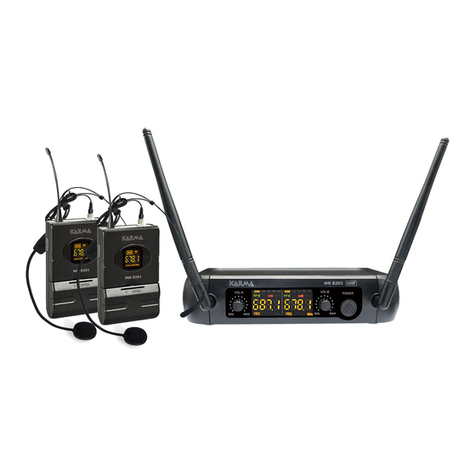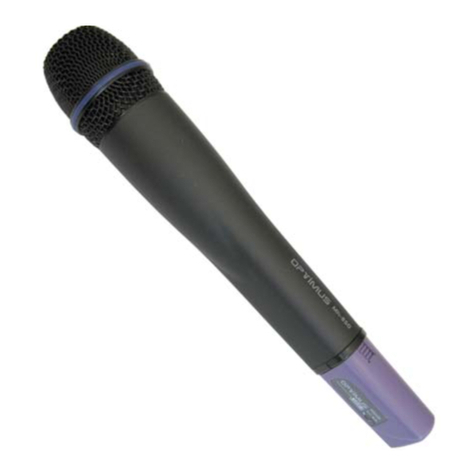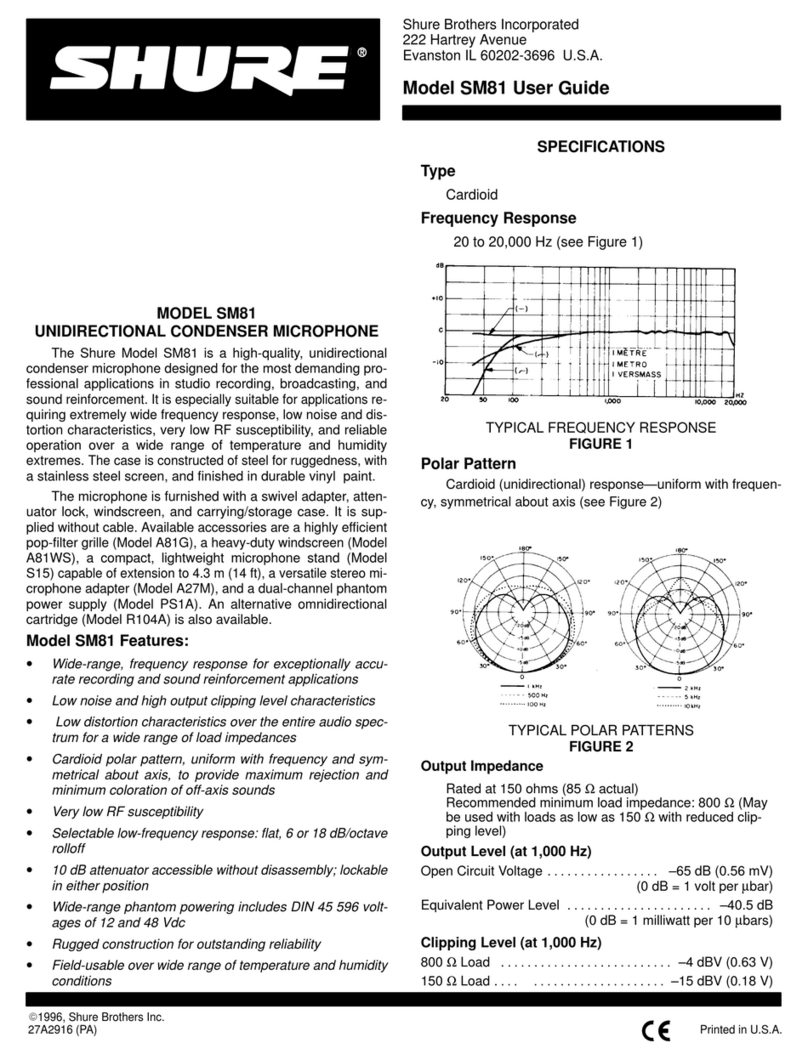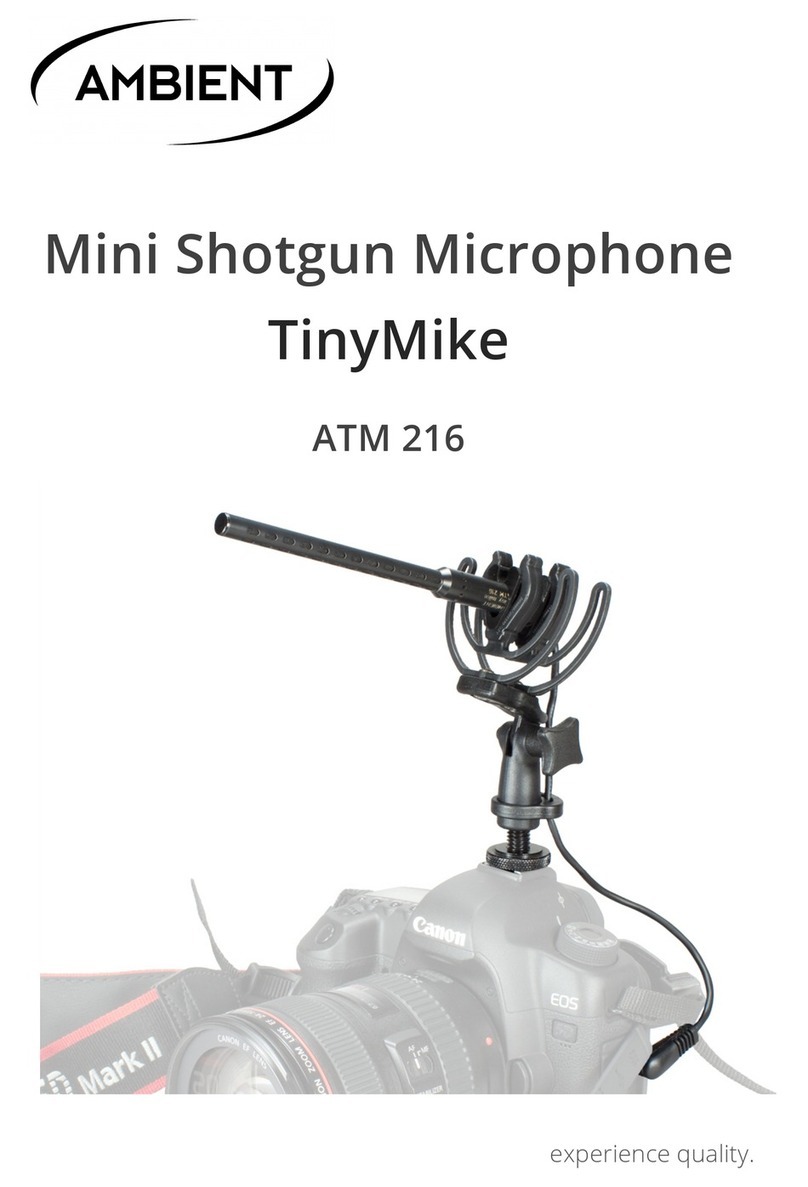Georg Neumann GmbH M 147 Tube User manual

Bedienungsanleitung
Operating Instructions
MARKETING / VERTRIEB
ENTWICKLUNG /SERVICE
Ollenhauerstr. 98
D-13403 Berlin
Tel.: +49-30 / 41 77 24-0
Fax: +49-30 / 41 77 24-50
Email: [email protected]
Web: www.neumann.com
FERTIGUNG / LAGER
Am Labor 1
D-30900 Wedemark M 147 Tube

23
Inhaltsverzeichnis
1. Kurzbeschreibung
2. Das Kondensatormikrophon M 147 Tube
2.1 Einige Zusatzinformationen zur Schaltungstech-
nik im M 147 Tube
2.2 Inbetriebnahme
2.3 Ausführungsform und Beschaltung des
Mikrophon- und Netzgeräteausgangs
2.4 Mikrophonkabel
3. Netzgerät
3.1 Betrieb an unsymmetrischen Eingängen
4. Technische Daten M 147 Tube
5. Frequenzgänge und Polardiagramme
6. Zubehör
1. Kurzbeschreibung
Das Kondensatormikrophon M 147 Tube ist ein
Großmembran-Studiomikrophon mit der Richtcharak-
teristik Niere.
Als Eingangsstufe wird eine Röhre verwendet, um
deren charakteristische Klangeigenschaften zu nutzen.
Das M 147 Tube zeichnet sich aus durch
• besonders niedriges Eigengeräusch und hohe Aus-
steuerbarkeit,
• ein neu entwickeltes Schaltungskonzept mit einer
Röhre als Eingangsstufe und transformatorlosem
Ausgang,
• den vollen, reichen und warmen Klang des Röh-
renmikrophons.
Das Mikrophon hat einen symmetrischen, übertrager-
losen Ausgang und wird aus dem zugehörigen Netz-
gerät N 149 A gespeist.
Die Einsprechrichtung wird durch das Neumann-
Emblem gekennzeichnet.
Table of Contents
1. Description
2. The M 147 Tube
Condenser Microphone
2.1 Additional Information on the
M 147 Tube
Circuit Design
2.2 Getting Started
2.3 Type and Configuration of the Microphone and
Power Supply Outputs
2.4 Microphone Cables
3. Power Supply Unit
3.1 Operation with Unbalanced Inputs
4. M 147 Tube Technical Specifications
5. Frequency Responses and Polar Patterns
6. Accessories
1. Description
The M 147 Tube is a large diaphragm studio con-
denser microphone with a capsule with cardioid
polar pattern.
The input stage is a vacuum tube (valve) with the
sound properties unique to this type of device.
The M 147 Tube is characterized by
• very low inherent self-noise and a wide dynamic
range
• a newly developed circuit design with a vacuum
tube input stage and a transformerless output
stage
• the full, rich and warm sound of a tube micro-
phone.
The microphone has a balanced transformerless out-
put and is powered by the included
N 149 A power
supply unit.
The front of the microphone is designated by the
Neumann logo.
2. Das Kondensatormikrophon
M 147 Tube
Das Kondensatormikrophon M 147 Tube ist ein
transformatorloses Röhren-Mikrophon. Es ist mit der
Doppelmembran-Kapsel K 47 bestückt, die in den le-
gendären Mikrophonen U 47 und M 49 bekannt und
berühmt geworden ist („M 7-Kapsel“). Es ist – wie
seine Ahnen – besonders für Sprache und Gesang ge-
eignet. Dies nicht nur wegen seiner Kapsel, sondern
auch wegen des besonders niedrigen Ersatzgeräusch-
pegels.
Im M 147 Tube wird als Eingangsstufe eine Röhre
verwendet. Im Gegensatz zu früheren Röhrenmikro-
phonen folgt dann aber eine transformatorlose Aus-
gangsschaltung. Dieses in den „TLM”-Mikrophonen
bewährte Schaltungskonzept ist besonders unemp-
findlich gegen kapazitive (Kabel-) Lasten. Es können
problemlos lange Mikrophonleitungen angeschlossen
werden, ohne daß es zu Klangverfälschungen im obe-
ren Übertragungsbereich kommt.
Durch die transformatorlose Schaltungstechnik wird
der Klang auch im unteren und mittleren Übertra-
gungsbereich allein durch die Kapsel und die Röhre
bestimmt. Bei früheren Röhrenmikrophonen beein-
flußte dagegen auch der Übertrager den Klangcharak-
ter, und zwar pegel-, frequenz- und lastabhängig. Die
transformatorlose Schaltungstechnik sorgt – wie ein
Übertrager – für eine gute Unsymmetriedämpfung.
Daher werden Störsignale, die auf die symmetrische
Modulationsleitung einwirken, wie gewohnt unter-
drückt.
Das M 147 Tube liefert mit ca. 20 mV/Pa einen für
Studiomikrophone üblichen Ausgangspegel. Dies re-
sultiert aus der Verstärkung des Kapselsignals durch
die Röhre um 10 dB. Damit bestimmt ausschließlich
die Röhre die Klangeigenschaften des Mikrophons
und nicht die folgende Ausgangsstufe. Der Eigenge-
räuschpegel des M 147 Tube ist besonders niedrig. Es
rauscht 3 ... 5 dB weniger als übliche Röhrenmikro-
phone.
Für den Korb wurde die verkleinerte Form des U 47
gewählt. Zum Schutz gegen Körperschallübertragung
ist die Kapsel, sowie die gesamte Schaltung, vom Ge-
häuse entkoppelt.
2.1 Einige Zusatzinformationen zur
Schaltungstechnik im M 147 Tube
Im Unterschied zu üblichen Röhrenmikrophonen wur-
de beim M 147 Tube eine besonders ausgesuchte
2. The M 147 Tube Condenser
Microphone
The M 147 Tube is a transformerless tube micro-
phone. It is equipped with the legendary dual-dia-
phragm capsule made famous in the U 47 and M 49
microphones (“M 7 capsule”). It is, like its predeces-
sors, especially suited to speech and vocal recording.
This is not only due to its capsule design, but also be-
cause of the extremely low inherent self-noise level.
A vacuum tube is used as the input stage of the
M 147 Tube. Unlike earlier tube microphones which
needed a transformer-coupled output stage, the
M 147 Tube uses a transformerless output stage. This
circuit design – proved to be effective in the “TLM”
series of microphones – is especially insensitive to ca-
pacitive (cable) loads. The microphone can therefore
be connected to long cables without the risk of high
frequency distortion.
Also due to the transformerless circuit design the
sound of the medium and lower frequencies is entire-
ly determined by the capsule and the tube. Earlier
tube microphones used a transformer which affect-
ed the sound quality depending on the volume, the
frequency and the load. The transformerless circuit
design of the M 147 Tube provides a very good com-
mon mode rejection factor just like a transformer. It
effectively attenuates signals influencing the balanced
audio signal.
The M 147 Tube has a typical studio microphone’s
sensitivity of approx. 20 mV/Pa. Internally, the tube
amplifies the capsule signal by 10 dB approx. Thus,
the sound of the M 147 Tube is exclusively deter-
mined by the tube, not by the following output stage.
The microphone‘s inherent self-noise is exceptionally
low: the noise level is 3 ... 5 dB lower than that of
comparable tube microphones.
The head grille of the M 147 Tube has the slightly
reduced shape as that of the U 47. The capsule as
well as the whole circuit are decoupled from hous-
ing to protect it against handling and structure-borne
noise.
2.1 Additional Information on the
M 147 Tube Circuit Design
In contrast to other tube microphones, the
M 147 Tube uses a combination of a specially select-

45
Triode mit modernster Schaltungstechnik kombiniert.
Ziel der Entwicklung war, die besonderen Übertra-
gungseigenschaften einer Röhre zu nutzen, und das
hiermit verstärkte Kapselsignal kontrolliert, unver-
fälscht und rückwirkungsfrei an den Mikrophonaus-
gang zu bringen. Daher wird der bei Röhrenmikro-
phonen übliche Ausgangsübertrager nicht verwendet.
Statt dessen wird zum Treiben der unterschiedlichen
Ausgangslasten ein besonders für Audiosignale geeig-
neter integrierter Verstärker mit sehr geringen Ver-
zerrungen, sehr kleiner Rauschspannung und hoher
Stromkapazität eingesetzt. So ist die Röhre völlig vom
Mikrophonausgang entkoppelt und wird mit ihrer
typischen Kennlinie bis zu sehr hohen Pegeln für die
Eingangssignalaufbereitung nutzbar. Im Gegensatz zu
herkömmlichen Röhrenmikrophonen sind aufgrund
der hohen Ausgangsstromkapazität Kabellängen bis
zu insgesamt 300 m erlaubt, ohne Einbußen in der
Signalqualität in Kauf nehmen zu müssen.
Die Röhre verstärkt die Kapselspannung um ca. 10 dB
und schließt Resteinflüsse der nachgeschalteten Elek-
tronik auf die Signalübertragung des Mikrophons
gänzlich aus. Dennoch wird ein sehr hoher Dynamik-
umfang bewältigt, da eine Spitzenausgangsleistung
von ± 10 V bei 20 mA zur Verfügung steht.
Der ideale Arbeitspunkt der Röhre wird während der
gesamten Lebensdauer stabilisiert. Das betrifft sowohl
den Anodenstrom als auch die Heizspannung, die
über einen Regelkreis im Netzgerät konstant gehal-
ten wird. Im Mikrophonkabel entstehende Span-
nungsabfälle bis zu 4 V = – das entspricht ca. 100 m
Kabel zwischen Mikrophon und Netzgerät – werden
durch eine Sensorleitung erfaßt und ausgeglichen.
Auch eine Störung dieser Leitung durch Kurzschluß
oder Unterbrechung ist ungefährlich, da für diesen
Fall eine Absenkung der Heizspannung und eine Ab-
schaltung aller weiteren Betriebsspannungen erfolgt.
Das Aufheizen der Röhre erfolgt in Hinblick auf eine
lange Lebensdauer schonend über eine rückläufige
Strombegrenzung.
Die für das Mikrophon benötigten Betriebsspannun-
gen werden aus dem Universal-Netzgerät N 149 A
unter Benutzung eines Schaltspannungsreglers ge-
wonnen. Eine analoge Vorregelung und doppelstufi-
ge aktive Filterung am Ausgang des Schaltreglers sor-
gen für Betriebsspannungen hoher Qualität mit sehr
geringen überlagerten Störspannungen.
Der NF-Ausgang des Netzgerätes ist mit besonderen
Schutzmaßnahmen versehen, die einen Betrieb des
Mikrophons ohne jegliche Einschränkung an mit 48 V-
Phantomspeisung belegten Modulationsdosen ermög-
lichen. Hierbei wird die Phantomspeisung mit ca.
1 mA belastet.
2.2 Inbetriebnahme
Das M 147 Tube wird als Set zusammen mit dem
8-adrigen Mikrophonkabel KT 8, dem Netzgerät
N 149 A und dem Stativgelenk SG 1 in einem Alu-
minium-Koffer geliefert. Das Stativgelenk SG 1 besitzt
ein 5/8"-27-Gang Innengewinde mit einem Reduzier-
stück für 1/2"- und 3/8"-Gewinde.
Zum Schutz der Mikrophonkapsel ist ein Textil-
Staubschutz beigefügt. Wird das Mikrophon längere
Zeit nicht benutzt, sorgt dieser für einen luftdurchläs-
sigen, effektiven Schutz vor Verschmutzung.
Zur Inbetriebnahme des Mikrophones ist die Reihen-
folge des Anschließens der Kabel unerheblich. Eine
Sensorik im Netzgerät sorgt dafür, daß die Betriebs-
spannungen erst bei funktionstüchtigem Anschluß des
Mikrophones hochgefahren werden. Die LED im
Netzgerät wechselt dann vom Glimmzustand auf ein
helles Leuchten über.
Nach spätestens einigen Minuten hat die Röhre im
M 147 Tube ihren stabilen Betriebszustand erreicht
und weist dann ihren besonders niedrigen Eigenge-
räuschpegel auf.
Eine eventuell anliegende externe Phantomspeisung
beeinträchtigt die Funktion des M 147 Tube nicht.
Wird eine externe Phantomspeisung an- oder abge-
schaltet, ergibt sich kurzzeitig ein leicht erhöhter Ei-
gengeräuschpegel.
Der Netzschalter des N 149 A unterbricht die Zulei-
tungen des eingebauten Netzteiles sekundärseitig.
Zur Stromersparnis sollte das N 149 A bei längerer
Nichtbenutzung vom Stromnetz getrennt werden.
Das M 147 Tube darf nur mit den Neumann-
Speisegeräten N 149, N 149 A oder N 149 V be-
trieben werden.
Abhängig vom Anwendungsfall werden folgende Zu-
behörteile zur Verbesserung der Signalqualität und
zum Schutz des Mikrophones vor Verschmutzung
empfohlen:
• Elastische Aufhängung EA 1
• Windschutz WS 87
• Popschutz PS 10 und PS 20.
Nähere Angaben dazu im Kapitel „Zubehör“.
2.3 Ausführungsform und Beschaltung des
Mikrophon- und Netzgeräteausgangs
Das Mikrophon hat eine nickelmatte Oberfläche. Der
8-polige Stecker des Mikrophons und des Netzgerä-
tes ist folgendermaßen beschaltet:
ed triode and state-of-the-art circuitry. The develop-
ers‘ aim was both to utilize the advantageous prop-
erties of a vacuum tube for amplifying the capsule sig-
nal and to exclude any interference from other parts
of the circuitry when the amplified signal is fed to the
microphone output. This is why the M 147 Tube –
unlike conventional tube microphones – does not
use an output transformer but an integrated amplifi-
er to drive the different output loads. This special
audio amplifier features an extremely low THD, low
self-noise and high current capacity. Thus, the vacu-
um tube is entirely decoupled from the microphone
output, and the typical tube characteristic can be
used for processing highest input signal levels. In con-
trast to conventional tube microphones the high out-
put current of the M 147 Tube allows cable lengths
of up to 300 m without risking a deterioration of sig-
nal quality.
The tube amplifies the capsule voltage by about 10 dB
to exclude any remaining impact of the electronics on
the microphone signal. Despite this amplification the
dynamic range of the M 147 Tube remains very wide
as the microphone delivers a peak output voltage of
± 10 V at 20 mA.
During its entire life, the operating point of the tube is
kept stable. This refers both to the anode current and
to the heater voltage which is stabilized by a control
loop in the power supply unit. Cable losses of up to
4 V DC –which corresponds to a cable length of ap-
prox. 100 m between the microphone and the power
supply unit – are detected and compensated for by a
sensor line. A breakdown of this line due to a short-
circuit or an open circuit is not dangerous as the
heater voltage would automatically be reduced and all
other voltages switched off. To ensure a long life, the
tube is heated very gently by current limiting with fold-
back characteristic.
The operating voltages for the M 147 Tube are de-
livered by the power supply unit N 149 A using a
switching regulator. Analog pre-controlling and two-
stage active filtering at the switching regulator‘s out-
put ensure high quality operating voltages with a min-
imum of unwanted interfering voltages.
The signal output of the power supply unit is provid-
ed with special protective circuitry so that the micro-
phone can be connected to audio inputs with 48 V
phantom powering without any problems. The load
on the phantom power source will be approx. 1 mA.
2.2 Getting Started
The M 147 Tube comes complete with KT 8 eight-
core microphone cable, N 149 A power supply unit,
SG 1 swivel mount and an aluminium case. The stand
connector of the SG 1 swivel mount has a 5/8"-27 in-
ternal (female) thread and comes complete with an
adaptor to convert to 1/2" and 3/8" threads.
A cloth dustcover is included to protect the micro-
phone capsule. This provides breathable, effective
protection against contamination if the microphone
goes unused for long periods.
When hooking up the microphone, the order in
which the cables are connected does not matter. A
sensor in the power supply ensures that the operat-
ing voltages are not run up until the microphone is
connected properly. The LED on the power supply
then changes from a low glow to shine brightly.
Within a few minutes, at the latest, the tube in the
M 147 Tube reaches its stable operating condition
and then evidences its particularly low residual noise
level.
External phantom power, if present, does not detract
from the performance of the M 147 Tube. If an ex-
ternal phantom power source is switched on or off,
only a short, slight rise in the residual noise level will
result.
The on/off switch of the N 149 A functions as a sec-
ondary voltage interrupt for the feeds from the built-
in mains unit. To save energy, the N 149 A should be
unplugged from the wall outlet if it is not in opera-
tion for an extended period.
The M 147 Tube must only be operated with the
Neumann power supplies N 149, N 149 A or
N 149 V.
Depending on the application in question, we rec-
ommend using the following accessories to enhance
signal quality and protect the microphone from con-
tamination:
• EA 1 Elastic Suspension
• WS 87 Windscreen
• PS 10 and PS 20 Popscreen.
For details, see the topic "Accessories".
2.3 Type and Configuration of the
Microphone and Power Supply Outputs
The microphone is finished in matt nickel. The 8-pin
connector of the microphone and the corresponding
connector of the power supply unit have the follow-
ing configuration:

67
Pin 1: –70 V
Pin 2: +5 V
Pin 3: Modulation, +Phase
Pin 4: +70 V
Pin 5: Sensorleitung
Pin 6: Masse
Pin 7: +32 V
Pin 8: Modulation, –Phase
Das zum Lieferumfang gehörende 8-polige Kabel ver-
bindet das Mikrophon mit dem Netzgerät N 149 A.
Die Modulation liegt hier an einem 3-poligen
XLR-Stecker. Erforderliches Gegenstück: XLR 3F. Die
Zuordnung der Mikrophonanschlüsse entspricht
DIN 45 599, Kennzeichen „I“ bzw. IEC 268-12 (pin.
conn. 130-x-IEC 02).
Bei einem Schalldruckanstieg vor der vorderen Mikro-
phonmembran tritt an Stift 2 eine positive Spannung auf.
2.4 Mikrophonkabel
Für das M 147 Tube stehen folgende Kabel zur Ver-
fügung:
KT 8KT 8
KT 8KT 8
KT 8 ........................................ sw .............................. Best.-Nr. 08407
(gehört zum Lieferumfang)
10 m langes Mikrophonkabel mit 8-poligen DIN
45326-Steckverbindern. Verbindet das Mikrophon
mit dem Netzgerät N 149 A. Gehört zum Lieferum-
fang.
IC 3 mtIC 3 mt
IC 3 mtIC 3 mt
IC 3 mt ................................. sw .............................. Best.-Nr. 06543
10 m langes Mikrophonkabel, Durchmesser 5 mm, mit
Doppeldrallumspinnung als Abschirmung. Schwarz-
matte 3-polige XLR-Steckverbinder. Führt am Aus-
gang des Netzgerätes die Modulation weiter.
Andere Kabellängen sind auf Wunsch lieferbar.
Das Mikrophon ist besonders unempfindlich gegen
kapazitive Belastung. TIM- und Frequenzgangverzer-
rungen werden auch bei Verwendung sehr langer
Kabel nicht hervorgerufen. Daher sind für die Modu-
lation Kabellängen bis etwa 300 m erlaubt. Das
8-polige Kabel zwischen Mikrophon und Netzgerät
darf dabei bis etwa 100 m lang sein.
Pin 1: –70 V
Pin 2: +5 V
Pin 3: audio signal, +phase
Pin 4: +70 V
Pin 5: sensor line
Pin 6: ground
Pin 7: +32 V
Pin 8: audio signal, –phase
The included eight-core cable connects the micro-
phone to the N 149 A power supply unit.
At the power supply unit, the audio signal is availa-
ble at a 3-pin XLR socket which requires an XLR-
3F connector. The pin assignment corresponds to
DIN 45599, part “I” and IEC 268-12 (pin. conn.
130-x-IEC 02), respectively.
An increase in sound pressure at the microphone‘s
front diaphragm produces a positive voltage at pin 2.
2.4 Microphone Cables
The following cables are available for the
M 147 Tube:
KT 8KT 8
KT 8KT 8
KT 8 ........................................ blk .............................. Cat. No. 08407
(included in the supply schedule)
10 m microphone cable with 8-pin DIN 45326 con-
nectors. For connecting the microphone to the
N 149 A power supply unit. Included in the scope of
delivery.
IC 3 mtIC 3 mt
IC 3 mtIC 3 mt
IC 3 mt ................................. blk .............................. Cat. No. 06543
10 m long microphone cable, 5 mm in diameter, with
double twist (double helix) braiding as shield. Three-
pin XLR connectors, matt black. For feeding the
audio signal to mixing consoles, etc.
Custom-made cables are available on request.
The M 147 Tube microphone is especially insensi-
tive to capacitive loads. Even the use of long cables
does not cause TIM or frequency response distor-
tions. Thus, the audio signal cable can have a length
of up to approx. 300 m, the 8-core connecting ca-
ble between the microphone and the power supply
unit can be as long as approx. 100 m.
3. Netzgerät
Das Universal-Netzgerät N 149 A (gehört zum
Lieferumfang) kann in folgenden Ausführungsformen
geliefert werden:
NN
NN
N149149
149149
149 A EuroA Euro
A EuroA Euro
A Euro ................. sw ............................. Best.-Nr. 08447
NN
NN
N149149
149149
149 A USA US
A USA US
A US ...................... sw ............................. Best.-Nr. 08446
N 149 A UKN 149 A UK
N 149 A UKN 149 A UK
N 149 A UK ..................... sw ............................. Best.-Nr. 08448
Die unterschiedlichen Versionen der Netzgeräte un-
terscheiden sich lediglich durch ihre Netzkabel.
Das Vintage-Netzgerät N 149 V kann in folgenden
Ausführungsformen geliefert werden:
N 149 V EuroN 149 V Euro
N 149 V EuroN 149 V Euro
N 149 V Euro ....................................... Best.-Nr. 12253.00101
N 149 V USN 149 V US
N 149 V USN 149 V US
N 149 V US ............................................ Best.-Nr. 12253.00201
N 149 V UKN 149 V UK
N 149 V UKN 149 V UK
N 149 V UK ........................................... Best.-Nr. 12253.00301
Die unterschiedlichen Versionen der Netzgeräte un-
terscheiden sich lediglich durch ihre Netzkabel.
3.1 Betrieb an unsymmetrischen Eingängen
Das Netzgerät N 149 A hat einen symmetrischen,
gleichspannungsfreien Ausgang. Die Zuordnung der
Mikrophonanschlüsse entspricht DIN 45 599, Kennzei-
chen „I“ bzw. IEC268-12 (pin. conn. 130-X-IEC 02):
Pin 1: 0 V, Masse
Pin 2: Modulation, +Phase
Pin 3: Modulation, –Phase
Pin 2 ist also die „heiße Phase“, und Pin 3 muß für
unsymmetrische Eingänge an Masse gelegt werden
(siehe Abbildung 1).
3. Power Supply Unit
The N 149 A (included in the supply schedule) pow-
er supply unit is available in the following versions:
N 149 A EuroN 149 A Euro
N 149 A EuroN 149 A Euro
N 149 A Euro .................. blk .............................. Cat. No. 08447
N 149 A USN 149 A US
N 149 A USN 149 A US
N 149 A US ...................... blk .............................. Cat. No. 08446
N 149 A UKN 149 A UK
N 149 A UKN 149 A UK
N 149 A UK ..................... blk .............................. Cat. No. 08448
The three available versions of the N 149 A just dif-
fer in their enclosed mains power cable.
The N 149 V vintage power supply unit is available
in the following versions:
N 149 V EuroN 149 V Euro
N 149 V EuroN 149 V Euro
N 149 V Euro ........................................ Cat. No. 12253.00101
N 149 V USN 149 V US
N 149 V USN 149 V US
N 149 V US ............................................. Cat. No. 12253.00201
N 149 V UKN 149 V UK
N 149 V UKN 149 V UK
N 149 V UK ............................................ Cat. No. 12253.00301
The three available versions of the N 149 V just dif-
fer in their enclosed mains power cable.
3.1 Operation with Unbalanced Inputs
At the N 149
A power supply unit, the audio signal
is available at a balanced XLR-3 output. The pin
assignment corresponds to DIN 45 599, part “I” and
IEC268-12 (pin. conn. 130-x-IEC 02), respectively:
Pin 1: 0 V, ground
Pin 2: audio signal, +phase
Pin 3: audio signal, –phase
So pin 2 is the “hot phase”, pin 3 must be connect-
ed to ground when used with unbalanced inputs (see
figure 1).
Abb. 1 / Fig. 1

89
5. Frequenzgänge und Polardiagramme
Frequency Response and Polar Patterns
4. Technische Daten
M 147 Tube
Akustische Arbeitsweise ..................... Druckgradienten-
empfänger
Richtcharakteristik .............................................................. Niere
Übertragungsbereich .................................... 20 Hz...20 kHz
Feldübertragungsfaktor 1) ................................................ 20 mV/Pa
Nennimpedanz .............................................................. 50 Ohm
Nennlastimpedanz ................................................ 1000 Ohm
Ersatzgeräuschpegel CCIR 468-3............................ 24 dB
Ersatzgeräuschpegel DIN/IEC 651 ................... 12 dB-A
Geräuschpegelabstand CCIR 468-3 ...................... 70 dB
Geräuschpegelabstand DIN/IEC 651 .................... 82 dB
Grenzschalldruckpegel (Röhrencharakteristik)
für k < 0,5 % ...................................................................... 114 dB
für k < 5 % .......................................................................... 134 dB
Dynamikumfang des Verstärkers
DIN/IEC 651
für k < 0,5% 2) ...................................................................................... 102 dB
für k < 5% ............................................................................ 122 dB
Max. Ausgangsspannung dabei ................................. 8 dBu
Stromversorgung ................................. Netzgerät N 149 A
Erforderliche Steckverbinder:
Mikrophon ............................... Binder 8-pol. (DIN 45326)
Netzgerät ............................................................................. XLR 3F
Gewicht ................................................................................... 460 g
Abmessungen .................................. Ø 57 mm x 142 mm
1 Pa = 10 µbar
0 dB = 20 µPa
1) bei 1 kHz an 1 kOhm Nennabschlußimpedanz. 1 Pa = 94 dB SPL.
2) Klirrfaktor des Mikrophonverstärkers bei einer Eingangsspannung, die der
von der Kapsel beim entsprechenden Schalldruck abgegebenen Spannung
entspricht.
4. M 147 Tube Technical
Specifications
Acoustic operating principle ............ pressure gradient
transducer
Polar patterns .................................................................. cardioid
Frequency response ..................................... 20 Hz...20 kHz
Sensitivity 1) ..................................................................................... 20 mV/Pa
Nominal impedance .................................................. 50 ohms
Nominal load impedance ................................ 1000 ohms
Equivalent SPL CCIR 468-3 ........................................ 24 dB
Equivalent SPL DIN/IEC 651 ............................... 12 dB-A
S/N ratio CCIR 468-3..................................................... 70 dB
S/N ratio DIN/IEC 651 .................................................. 82 dB
Max. SPL (tube characteristic)
for THD < 0.5 % ............................................................. 114 dB
for THD < 5 % ................................................................. 134 dB
Dynamic range of the amplifier
DIN/IEC 651
for THD < 0.5% 2) .......................................................................... 102 dB
for THD < 5% ................................................................... 122 dB
Max. output voltage.......................................................... 8 dBu
Power supply ................................................................. N 149 A
Required connectors:
Microphone.............................. Binder 8-pin (DIN 45326)
Power supply unit .......................................................... XLR 3F
Weight ...................................................................................... 460 g
Dimensions......................................... Ø 57 mm x 142 mm
1 Pa = 10 µbar
0 dB = 20 µPa
1) at 1 kHz and 1 kohm nominal terminating impedance. 1 Pa = 94 dB
SPL.
2) THD of the microphone amplifier at an input voltage which is equivalent
to the capsule output voltage at the specified SPL.

10 11
zapfen. Dieser wird in ein Stativgelenk geschraubt,
das Mikrophonkabel wird in die Kabelhalterung ge-
klemmt und dort fixiert. Dadurch wird die Einstellung
der Neigung eines frei an seinem Kabel hängenden
Mikrophons ermöglicht.
6.5 Elastische Aufhängung
Um mechanische Erschütterung fernzuhalten, emp-
fiehlt sich die Verwendung einer elastischen Mikro-
phonaufhängung.
EA 1EA 1
EA 1EA 1
EA 1 ........................................ ni ................................. Best.-Nr. 08449
EA 1 mtEA 1 mt
EA 1 mtEA 1 mt
EA 1 mt ............................... sw .............................. Best.-Nr. 08450
Die EA 1 ist für die Mikrophone TLM 103, TLM 193
und M 147 Tube vorgesehen. Der schwenkbare Ge-
windeanschluß zur Befestigung auf Stativen hat 5/8"-
27-Gang. Ein Reduzierstück zur Verbindung mit 1/2"-
und 3/8"-Gewindezapfen wird mitgeliefert.
6.6 Windschirme
Zum Vermeiden von Störgeräuschen, die bei Nahbe-
sprechung, Windeinfluß oder z.B. bei schnellem
Schwenken des Mikrophongalgens auftreten können,
sind Windschutzeinrichtungen aus offenporigem Po-
lyurethanschaum lieferbar. Diese Windschirme erzeu-
gen keine störenden Resonanzen und beeinflussen
nicht die Richtcharakteristik des Mikrophons. Das
Übertragungsmaß wird im oberen Frequenzbereich
geringfügig gedämpft.
WSWS
WSWS
WS 8787
8787
87 ................................... sw .............................. Best.-Nr. 06753
Windschutz für M 147 Tube. Durchmesser ca. 90 mm.
Dämpfung des Windgeräusches ca. 26 dB. Dämpfung
bei 15 kHz ca. 3 dB. Farbe schwarz.
6.7 Popschutz
PS 10PS 10
PS 10PS 10
PS 10 ...................................... sw .............................. Best.-Nr. 07345
PS 20PS 20
PS 20PS 20
PS 20 ...................................... sw .............................. Best.-Nr. 07346
Die Popschirme PS 10 und PS 20 bieten einen sehr
wirksamen Schutz vor den sogenannten Popgeräuschen.
Sie bestehen aus einem runden dünnen Holzrahmen,
der beidseitig mit schwarzer Gaze bespannt ist.
Der um ca. 230° schwenkbare Stativanschlußstutzen
hat 5/8"-27-Gang-Innengewinde mit einem Reduzierstück
zur Verbindung mit 1/2"- und 3/8"-Gewindezapfen.
Zum Lieferumfang gehört ein zweiseitig konterbarer
Gewindezapfen, um einen Popschirm z.B. an die Klam-
mer MKV zu schrauben. Damit kann er an die Stativ-
stangen oder an die Steckverbinder geklammert wer-
den.
with a swivel mount. The stud is screwed into the
threaded coupling of the swivel mount. Then the
microphone can be tilted while it is suspended from
its own cable.
6.5 Elastic Suspension
The use of an elastic suspension is recommended
to prevent the microphone from being exposed to
strong mechanical vibrations caused by structure
borne shock waves.
EA 1EA 1
EA 1EA 1
EA 1 ........................................ ni ................................. Cat. No. 08449
EA 1 mtEA 1 mt
EA 1 mtEA 1 mt
EA 1 mt ............................... blk .............................. Cat. No. 08450
The EA 1 is designed for the TLM 103, TLM 193 and
M 147 Tube microphones. It has a swivel mount with
a 5/8"-27 female thread that can be fastened to
tripods. Included is a threaded adapter to connect to
1/2"- and 3/8" studs.
6.6 Windshields
To protect against noise caused by wind, close talk-
ing, and rapid movement on a boom, opencell poly-
urethane foam windshields are available. These wind-
shields have no disturbing resonances and do not
affect the microphone’s directional characteristic. The
frequency response is only slightly attenuated in the
higher frequency range.
WSWS
WSWS
WS 8787
8787
87 ................................... blk .............................. Cat. No. 06753
Windscreen for M147 Tube. Diameter is approx.
90 mm. Suppression of the wind noise approx. 26 dB.
Attenuation at 15 kHz approx. 3 dB. Color black.
6.7 Popscreens
PS 10PS 10
PS 10PS 10
PS 10 ...................................... blk .............................. Cat. No. 07345
PS 20PS 20
PS 20PS 20
PS 20 ...................................... blk .............................. Cat. No. 07346
The PS 10 and PS 20 popshields provide excellent
suppression of so-called pop noise. They consist of a
round, thin wooden frame covered with black gauze
on both sides.
The stand adaptor with 5/8"-27 female thread can be
altered by 230°. A reducer for connection to 1/2" and
3/8" studs is included.
For mounting a popshield to the MKV quick-release
clamp, a double-sided stud with locknut is included in
the supply schedule. Used in conjunction with the
MKV quick-release clamp the popshields can be
attached to stands or connectors.
6. Accessories
Further articles are described in the catalog “Accessories”.
6.1 Swivel Mount
SG 1SG 1
SG 1SG 1
SG 1 ......................................... blk .............................. Cat. No. 08445
(included in the supply schedule)
The SG 1 swivel mount connects to the bottom part
of the M 147 Tube microphone, which then can be
mounted to microphone stand. The microphone
mount of the SG 1 is made of metal. The swivel
mount has a 5/8"-27 thread, and a thread adapter for
connecting to 1/2" and 3/8" studs.
6.2 Table and Floor Stands
MF 3MF 3
MF 3MF 3
MF 3 ....................................... blk .............................. Cat. No. 07321
Table stand with iron base, 1.6 kg, 110 mm in diam-
eter. The table stand has a matt black finish and rests
on a nonskid rubber disk attached to the bottom. A
reversible stud and a reducer for 1/2" and 3/8"
threads are also supplied.
MF 4MF 4
MF 4MF 4
MF 4 ....................................... blk .............................. Cat. No. 07337
Floor stand with grey cast iron base, 2.6 kg, 160 mm
in diameter. The floor stand has a matt black finish
and rests on a nonskid rubber disk attached to the
bottom. A reversible stud and a reducer for 1/2" and
3/8" threads are also supplied.
6.3 Stand Extensions
The STV... stand extensions are used between micro-
phone and floor stands to provide table or floor
stands of variable heights.
The STVs are 40, 200, 400 or 600 mm long.
Diameter: 19 mm.
STVSTV
STVSTV
STV 44
44
4 ...................................... blk .............................. Cat. No. 06190
STVSTV
STVSTV
STV 2020
2020
20 ................................... blk .............................. Cat. No. 06187
STVSTV
STVSTV
STV 4040
4040
40 ................................... blk .............................. Cat. No. 06188
STVSTV
STVSTV
STV 6060
6060
60 ................................... blk .............................. Cat. No. 06189
6.4 Auditorium Hanger and Suspensions
MNVMNV
MNVMNV
MNV 8787
8787
87 ............................... ni ................................. Cat. No. 06804
MNVMNV
MNVMNV
MNV 87 mt87 mt
87 mt87 mt
87 mt ....................... blk .............................. Cat. No. 06806
The auditorium hanger consists of a cable suspension
and a rotating 1/2" threaded stud. It is used together
6. Zubehör
Weitere Artikel sind im Katalog „Zubehör” beschrieben.
6.1 Stativgelenke
SG 1SG 1
SG 1SG 1
SG 1 ......................................... sw ............................. Best.-Nr. 08445
(gehört zum Lieferumfang)
Das Stativgelenk SG 1 kann an das Bodenstück des Mi-
krophones M 147 Tube geschraubt werden und dient
zur Befestigung dieses Mikrophones auf einem Stativ. Die
Halterung des SG 1 ist aus Metall, der Gewindeanschluß
hat 5/8"-27-Gang. Ein Reduzierstück zur Verbindung mit
1/2"- und 3/8"-Gewindezapfen wird mitgeliefert.
6.2 Tisch- und Fußbodenständer
MF 3MF 3
MF 3MF 3
MF 3 ....................................... sw .............................. Best.-Nr. 07321
Der Mikrophonfuß MF 3 ist ein Tischständer mit Eisen-
fuß, 1,6 kg schwer, Durchmesser 110 mm. Der Ständer
ist schwarzmatt lackiert und steht gleitfest auf einer
Moosgummischeibe. Ein umwendbarer Gewindezapfen
und ein mitgeliefertes Reduzierstück ermöglichen die
Verwendung für 1/2"- und 3/8"-Gewindeanschlüsse.
MF 4MF 4
MF 4MF 4
MF 4 ....................................... sw .............................. Best.-Nr. 07337
Der Mikrophonfuß MF 4 ist ein Fußbodenständer aus
Grauguß, ca. 2,6 kg schwer, Durchmesser 160 mm. Der
Ständer ist schwarzmatt lackiert und steht gleitfest auf
einem Gummiring. Ein umwendbarer Gewindezapfen
und ein mitgeliefertes Reduzierstück ermöglichen die
Verwendung für 1/2"- und 3/8"-Gewindeanschlüsse.
6.3 Stativverlängerungen
Die Stativverlängerungen STV... werden zwischen Fuß-
bodenständer und Mikrophonhalterung geschraubt.
Dadurch entstehen unterschiedlich hohe Tisch- oder
Fußbodenstative.
Die STV... haben eine Länge von 40, 200, 400 oder
600 mm. Durchmesser: 19 mm.
STVSTV
STVSTV
STV 44
44
4 ...................................... sw .............................. Best.-Nr. 06190
STVSTV
STVSTV
STV 2020
2020
20 ................................... sw .............................. Best.-Nr. 06187
STVSTV
STVSTV
STV 4040
4040
40 ................................... sw .............................. Best.-Nr. 06188
STVSTV
STVSTV
STV 6060
6060
60 ................................... sw .............................. Best.-Nr. 06189
6.4 Abhängevorrichtung
MNVMNV
MNVMNV
MNV 8787
8787
87 ............................... n i ............................... Best.-Nr. 06804
MNVMNV
MNVMNV
MNV 87 mt87 mt
87 mt87 mt
87 mt ....................... sw ............................. Best.-Nr. 06806
Die Mikrophonneigevorrichtung besteht aus einer
Kabelhalterung und einem drehbaren 1/2"-Gewinde-

IC 3 mt
MNV 87 (mt)
N 149 A
MF 4
N 149 V
MF 3
WS 87
Irrtümer und technische Änderungen vorbehalten • Errors excepted, subject to changes
Printed in Germany • Publ. 2/00 74932 / A 02
EA 1 (mt) STV...
PS 10 PS 20
Table of contents
Other Georg Neumann GmbH Microphone manuals
Popular Microphone manuals by other brands

Shure
Shure WL50 user guide
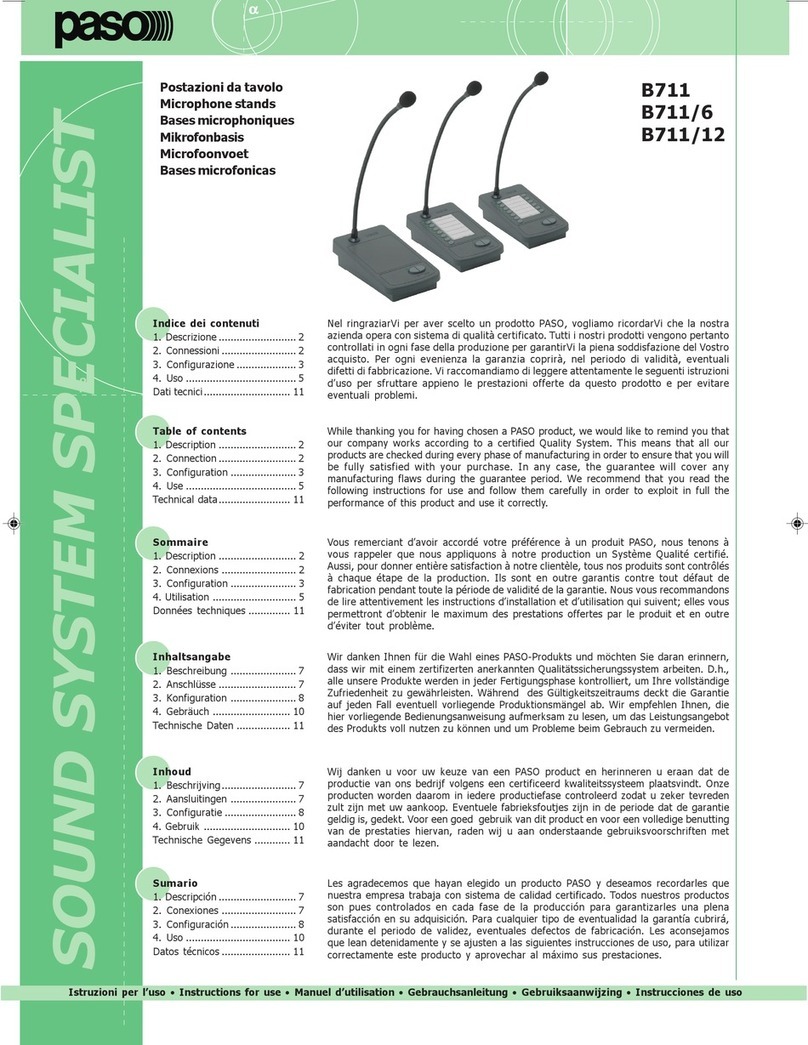
Paso
Paso B711 Instructions for use
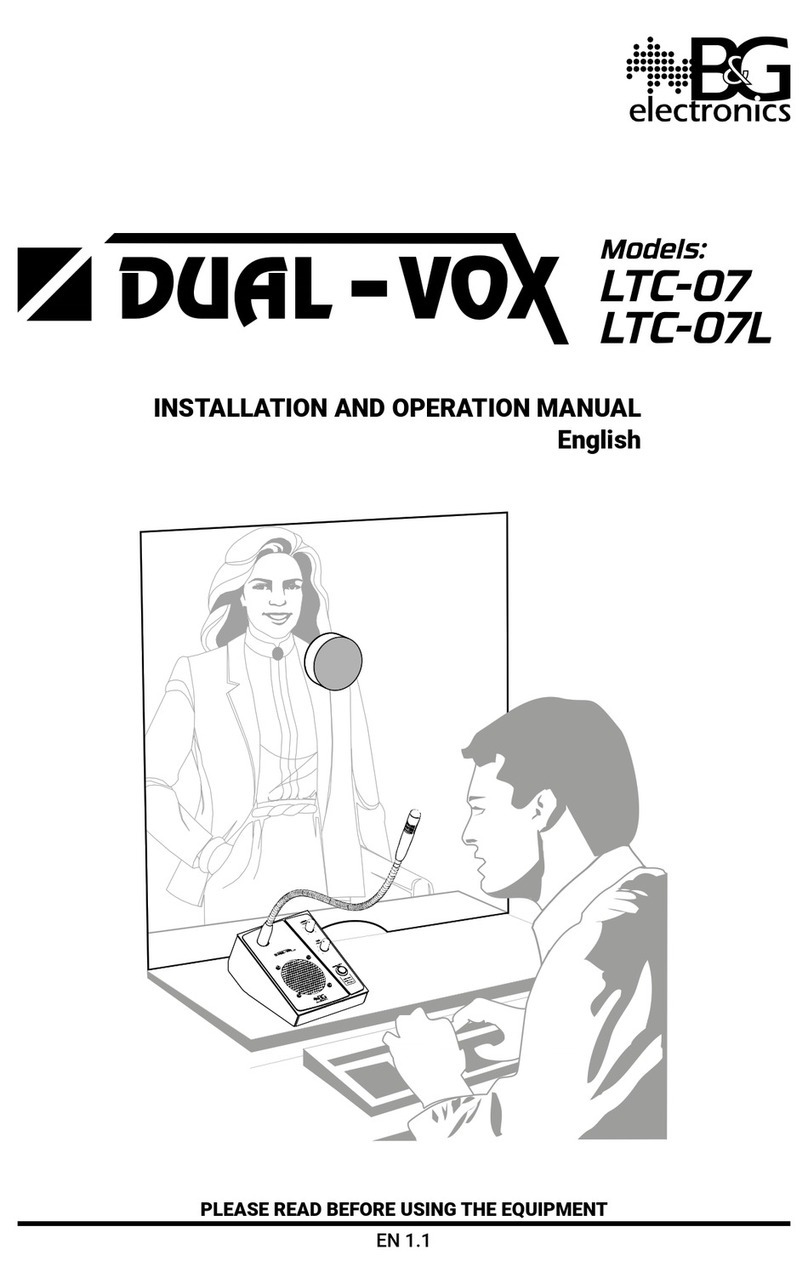
B&G electronics
B&G electronics DUAL-VOX LTC-07 Installation and operation manual

Behringer
Behringer SINGLE DIAPHRAGM CONDENSER MICROPHONES C-4 brochure

Electro-Voice
Electro-Voice C05 Specification sheet
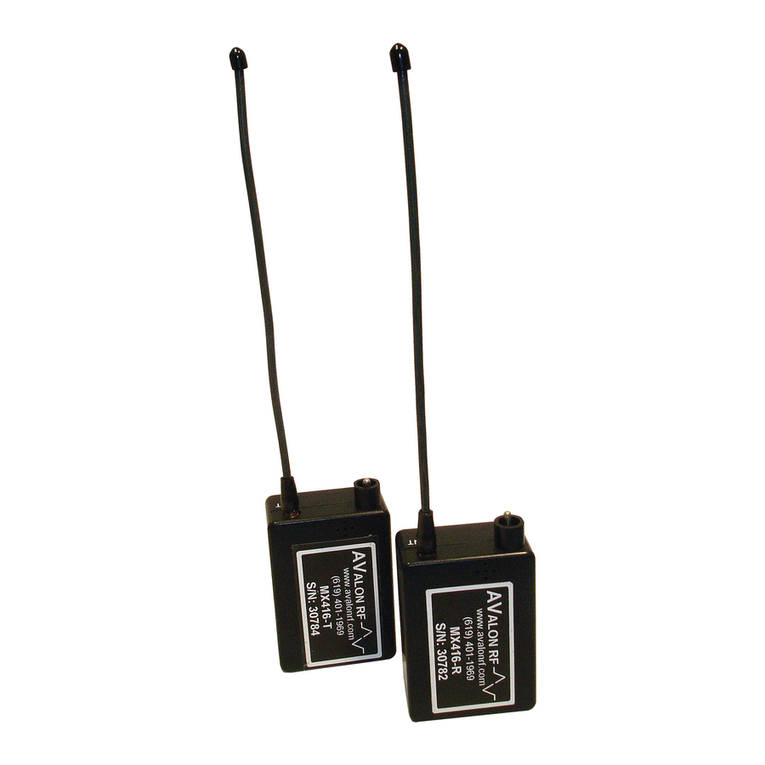
Avalon RF
Avalon RF MX416 User's guide & operating manual

